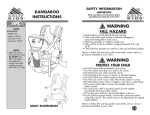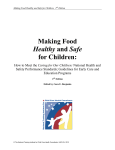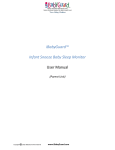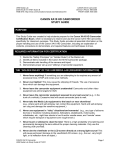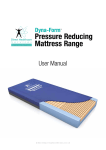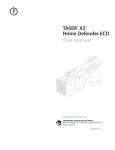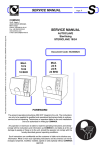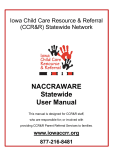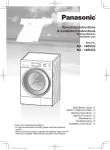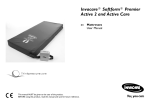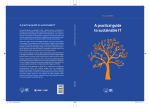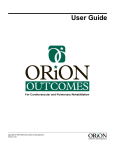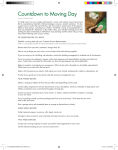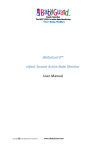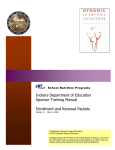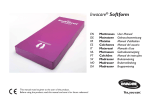Download User Manual - California Childcare Health Program
Transcript
Health and Safety Checklist for Early Care and Education Programs: Based on Caring for Our Children National Health and Safety Performance Standards Third Edition User Manual Developed by the California Childcare Health Program Funded by the UCSF School of Nursing 2014 © 2014 California Childcare Health Program, UCSF School of Nursing www.ucsfchildcarehealth.org User Manual Health and Safety Checklist for Early Care and Education Programs: Based on Caring for Our Children National Health and Safety Performance Standards, Third Edition This User Manual provides information about the development and use of the Health and Safety Checklist for Early Care and Education Programs: Based on Caring for Our Children National Health and Safety Performance Standards, Third Edition (CFOC3) (referred to as the Checklist). The manual explains how to complete the Checklist and how to rate the items on the Checklist. I. Background and Methodology of the Checklist The Checklist uses CFOC3 standards from Stepping Stones, 3rd Edition (SS3). It is a compilation of selected CFOC3 standards, which if followed, are most likely to prevent adverse outcomes for children/staff in early care and education (ECE) settings. CFOC3 standards are updated periodically and can be found on the National Resource Center website: http://cfoc.nrckids.org/. Of the 138 SS3 standards, 72 standards were determined to be observable. These 72 standards were used to establish the 112 items in the Checklist. Many of the items in the Checklist include several observable components of a standard. In addition, some standards are represented by more than one item. For this Checklist, observable is defined as the following: 1. Requires interaction with the staff or director only to ask where to find an item or identify products. For example, ask permission to open first aid kits, cabinets, etc. 2. Able to observe when walking through a program over a two-hour period of time. 3. The standard/item can be seen and evaluated in an objective way. 4. Observation may include opening windows, taking measurements (for example, measuring the depth of an impact surface or height of equipment), smelling for odors and reading labels (for example, checking dates on medication labels). 5. Does not require checking records or documents, such as child immunizations, professional development records or written program policies. The Checklist was designed to assess the key observable health and safety standards in ECE programs. The observer uses the Checklist to assess the space, equipment and function in a specific classroom and in overall facility. Anyone may use the Checklist to assess the health and safety of an ECE program, including Child Care Health Consultants, ECE Directors and Staff Members and Quality Improvement Coaches. II. Organization of the Checklist The Checklist includes 5 main sections: (1) Facilities, which includes Emergencies, Medications, Equipment and Furnishings, (2) Supervision, which includes Interaction and Physical Activity, Nutrition, (3) Sanitation, which includes Personal Hygiene, Food Safety/Food Handling, Environmental Health, (4) Pools, Spas, and Hot Tubs, and (5) Infants and Toddlers. The sections are broken down into subscales as follows. © 2014 California Childcare Health Program, UCSF School of Nursing, www.ucsfchildcarehealth.org 1 Section 1: FACILITIES: Emergencies, Medications, Equipment and Furnishings FACILITIES: Emergencies Medications Equipment and Furnishings - Indoors and Outdoors Equipment and Furnishings - Outdoors Only Section 2: SUPERVISION: Interaction and Physical Activity and Nutrition SUPERVISION Interaction and Physical Activity Nutrition Section 3: SANITATION: Personal Hygiene, Food Safety/Food Handling, Environmental Health SANITATION Personal Hygiene - Handwashing Personal Hygiene – Toothbrushing Food Safety/Food Handling Environmental Health Section 4: POOLS, SPAS, AND HOT TUBS Section 5: INFANTS AND TODDLERS: Personal Relationships Infants and Toddlers - Personal Relationships Infants and Toddlers -Diapering Infants and Toddlers – Injury Prevention Infants Only- Activity, Sleep, Safety Infant Only-Nutrition 1-41 1-10 11-13 14-35 36-41 42-59 42-52 53-59 60-85 60-64 65-66 67-74 75-85 86-88 89-112 89-90 91-92 93-97 98-106 107-112 III. Equipment Needed to Complete the Checklist Tape measure (at least 60 inches long) Rigid measuring stick to measure the depth of loose fill impact surfacing (at least 9 inches long). Refrigerator thermometer Stop watch or timer Clipboard and pen or electronic tablet No-Choke Testing Tube (optional) Fanny pack or back pack to carry equipment IV. Planning Your Visit 1. The items are organized in an order to facilitate making observations and rating items as you walk through a facility. 2. For the following items noted by an asterisk, *8-13, *21, *66, *81 *83, *84, *85, *105, you may need to ask the director or a staff member questions about the item (for example, where toxic substances are stored). 3. Inform the director that you will need to open cabinets, read labels, open windows, and measure heights of equipment and depths of impact surfaces. 4. Bring your own equipment to complete the Checklist. Start your visit by putting the thermometer in the refrigerator, since it takes at least one hour to accurately read the temperature (#70; Std. 4.9.0.3). © 2014 California Childcare Health Program, UCSF School of Nursing, www.ucsfchildcarehealth.org 2 5. Pick a classroom to observe indoors and outdoors. When the children mix with other classes, observe the overall environment in the program and rate what you observe in the overall program. 6. Items #4, #6, #7 relate to the full program and not one classroom. V. Rating Scale The 112 items objectively describe key observable components of 72 CFOC3 standards. Each item is rated on the following scale: 1 = Never. None of the components of the item are met. 2 = Sometimes. Less than or 50% (≤ 50%) of the components in the item are met. 3 = Usually. More than 50% (>50%) but less than 100% of the components in the item are met. 4 = Always. Every component in the item is met (100%). NA = The item is not applicable (N/A) to the classroom/program. Explain why it is rated N/A in the ‘notes’ section. N Op = There was no opportunity (N Op) to observe this item. Explain why it is rated N Op in the ‘notes’ section. When a rating area is shaded grey, the rating choice is not an option. Notes: After each item, there is a space for notes and/or comments. Use this space to document why the classroom/program does not meet 100% of the components of the item or why the item was not applicable or not observed. Also, write notes about issues needing follow-up or discussion with program staff. At the end of each subscale, there is space to list and rate other federal, state, local and/or accreditation standards/regulations that may apply. © 2014 California Childcare Health Program, UCSF School of Nursing, www.ucsfchildcarehealth.org 3 Item-By-Item Specifications FACILITIES: Emergencies 1. A sign-in/sign-out system tracks who (other than children) enters and exits the facility. It includes name, contact number, purpose of visit (for example, parent/guardian, vendor, guest, consultant) and time in and out. (Std. 9.2.4.7) Note: If the sign-in/sign-out log is not easily visible, ask to see it. The sign-in/sign-out system is for all persons other than children entering and exiting the facility. 1 = There is no sign-in/sign-out system. 2 = There is a sign-in/sign-out system that meets ≤ 50% of the components of the item. For example, the sign-in/sign-out system includes name and contact number, but not the relationship to facility nor the recorded time in and out. 3 = There is a sign-in/sign-out system that meets >50% of the components of the item. For example, the sign-in/sign-out system includes name and contact number and the relationship to facility, but not the recorded time in and out. 4 = There is a sign-in/sign-out system that tracks who (other than children) enters and exits the facility. The system includes name, contact number, relationship to facility (for example, parent/guardian, vendor, guest, consultant) and recorded time in and out. 2. Phone numbers to report child abuse and neglect (Child Protective Services) are clearly posted where any adult can easily see them. (Std. 3.4.4.1) 1 = No phone numbers to report child abuse and neglect are posted. 2= Phone numbers to report child abuse and neglect are available on site, but not posted. 3 = Phone numbers to report child abuse and neglect are posted but not easily seen. 4 = Phone numbers to report child abuse and neglect are clearly posted where any adult can easily see them. 3. Phone number for the Poison Center is posted where it can be seen in an emergency (for example, next to the phone). (Stds. 5.2.9.1, 5.2.9.2) Note: The National help line for the poison center is 1-800-222-1222. The number should be clearly visible to the rater and is either posted near the phones or in a convenient location. 1 = The Poison Control number is not posted where it can be seen in an emergency, and not available onsite. 2 = The Poison Control number is available on site but not posted. 3 = The Poison Control number is posted on site but not easily seen. 4 = The Poison Center number is posted and can be easily seen in an emergency. 4. Fire extinguishers are inspected annually. Check date on fire extinguisher tag. (Std. 5.1.1.3) Note: Check that the center complies with state-approved or nationally recognized fire prevention code. Inspect all fire extinguishers in the facility for written documentation of annual inspections. 1 = None of the fire extinguishers have a date of last inspection within 1 year. 2 = ≤ 50% of the fire extinguishers have a date of last inspection within 1 year. 3 = > 50% of the fire extinguishers have a date of last inspection within 1 year. 4 = All of the fire extinguishers have a date of last inspection within 1 year. © 2014 California Childcare Health Program, UCSF School of Nursing, www.ucsfchildcarehealth.org 4 5. Each building or structure has at least two unobstructed exits leading to an open space at the ground floor. (Std. 5.1.4.1) Note: Assess each exit on each floor in the facility (above or below ground level) that is used for child care. 1 = There are no unobstructed exits leading to an open space at the ground level. 2 = ≤ 50% of the exits are both unobstructed and lead to an open space at the ground level. 3 = >50% of the exits are both unobstructed and lead to an open space at the ground level. 4 = Every building or structure has two or more unobstructed exits leading to an open space at the ground floor. 6. Smoke detector system or alarm is in working order in each room or place where children spend time. (Std. 5.2.5.1) 1 = There are no working smoke detector systems in the facility. 2 = ≤ 50% of the rooms where children spend time have a working smoke detector system. 3 = > 50% of the rooms where children spend time have a working smoke detector system 4 = There is a working smoke detector system in every room where children spend time. 7. * Carbon monoxide detectors are outside of sleeping areas. (Std. 5.2.9.5) Note: Carbon monoxide detectors may be found placed on the walls or ceiling and\or may be combined with smoke detectors. You may need to ask the director or a staff member about carbon monoxide detectors. 1 = There are no carbon monoxide detectors outside of sleeping areas. 2 = Carbon monoxide detectors are present outside of ≤ 50% of sleeping areas. 3= Carbon monoxide detectors are present outside of > 50% of sleeping areas. 4 = Carbon monoxide detectors are present outside of all sleeping areas. NA = The center does not have any children that sleep or nap on site. 8. *First aid supplies are well-stocked in each location where children spend time. (Std. 5.6.0.1) Note: Ask where the first aid kit is kept. Examine the contents of the kit(s). Each kit must be fully equipped and the supplies should not be stored separately. The kit(s) must be in the location where children spend time and/or immediately accessible. For the rater’s reference the National Health and Safety Performance Standards recommend that the first aid kit contain at least these 23 supplies: a. Disposable nonporous, latex free or non-powdered latex gloves (latex-free recommended); b. Scissors; c. Tweezers; d. Non-glass, non-mercury thermometer; e. Bandage tape; f. Sterile gauze pads; g. Flexible roller gauze; h. Triangular bandages; i. Safety pins; j. Eye patch or dressing; k. Pen/pencil and note pad; l. Cold pack; © 2014 California Childcare Health Program, UCSF School of Nursing, www.ucsfchildcarehealth.org 5 m. Current American Academy of Pediatrics (AAP) standard first aid chart or equivalent first aid guide such as the AAP Pediatric First Aid For Caregivers and Teachers (PedFACTS) Manual; n. Coins for use in a pay phone and cell phone; o. Water (two liters of sterile water for cleaning wounds or eyes); p. Liquid soap to wash injury and hand sanitizer; q. Tissues; r. Wipes; s. Individually wrapped sanitary pads to contain bleeding of injuries; t. Adhesive strip bandages, plastic bags for cloths, gauze, and other materials used in handling blood; u. Flashlight; v. Whistle; w. Battery powered radio 1 = None of the supplies listed above are in the first aid kit. 2 = ≤ 50% (less than or equal to 11) of the supplies are in the first aid kit. 3 = > 50% (12 or more) of the supplies are in the first aid kit. 4 = 100% (23) of all the supplies are in the first aid kit. 9. * First aid supplies are kept in a closed container, cabinet or drawer that is labeled. They are stored out of children’s reach and within easy reach of staff. (Std. 5.6.0.1) 1 = None of the first aid supplies are kept in a closed container, cabinet or drawer that is labeled and inaccessible to children or there are no first aid supplies present at the facility. 2 = ≤ 50% of the components in this item are met. 3 = >50% of the components in this item are met. 4 = All first aid supplies are kept in a closed container, cabinet or drawer that is labeled and inaccessible to children. 10. * A well-stocked first aid kit is ready for staff to take along when they leave the facility with children (for example, when going on a walk, a field trip or to another location). (Std. 5.6.0.1) Note: The first aid kit is used when children leave the facility for a walk or by vehicle to another location.The transportable first aid kit should include ALL items listed above (# 8) AND the following emergency information/items: a. List of children in attendance (organized by caregiver/teacher they are assigned to) and their emergency contact information (for example, parents/guardian/emergency contact with home, work, and cell phone numbers); b. Special care plans for children who have them; c. Emergency medications or supplies as specified in the special care plans; d. List of emergency contacts (for example, location information and phone numbers for the Poison Center, nearby hospitals or other emergency care clinics, and other community resource agencies); e. Maps; f. Written transportation policy and contingency plans 1 = There is no transportable first aid kit available. 2 = There is a transportable first aid kit that is readily available with ≤ 50% of the first aid with the required supplies. © 2014 California Childcare Health Program, UCSF School of Nursing, www.ucsfchildcarehealth.org 6 3 = There is a transportable first aid kit that is readily available with > 50% of the required first aid supplies. 4 = There is a transportable first aid kit that is readily available that has all of the listed information and items. NA = Children do not go on walks, field trips or otherwise leave the facility with staff. FACILITIES: Medications Ask where medications are stored. If no medications are stored on site, mark “NA” for these items. 11. * Medications are stored in an organized fashion and are not expired. They are stored at the proper temperature, (for example, in the refrigerator or at room temperature according to instructions) out of children’s reach and separated from food. (Std. 3.6.3.2) 1 = Medications are not organized and not stored at the proper temperature, out of children’s reach and separated from food. 2 = ≤ 50% of the components in this item are met. 3 = >50% of the components in this item are met. 4 = All medications are organized and stored at the proper temperature, out of children’s reach and separated from food. NA = There are no medications stored on site. 12. *Over-the-counter medications are in the original containers. They are labeled with the child’s name. Clear written instructions from the child’s health care provider are with the medication. (Stds. 3.6.3.1, 3.6.3.2) Note: Written instructions from the child’s health care provider can be by note, email or fax. Sunscreen and insect repellant do not need to meet this standard. 1 = Over-the-counter medications are not appropriately stored, labeled, and accompanied by instructions. 2 = ≤ 50% (only one) of the components are met. 3 = >50% (2 out of 3) of the components in this item are met. 4 = All over-the-counter medications are in the original containers, are appropriately labeled, and have clear written instructions. NA = There are no over-the-counter medications stored on site. N Op = There was no opportunity to observe over-the-counter medications. 13. *Prescription medications are in their original, child resistant container, labeled with child’s name, date filled, prescribing health care provider’s name, pharmacy name and phone number, dosage, instructions, and warnings. (Stds. 3.6.3.1, 3.6.3.2) 1 = Prescription medications are not in their original, child resistant container, labeled with child’s name, date filled, prescribing health care provider’s name, pharmacy name and phone number, dosage/instructions, and warnings. 2 = ≤ 50% (5 or less) of the components are met. 3 = > 50% (6 or more) of the components are met. 4 = All prescription medications are in their original, child resistant container, labeled with child’s name, date filled, prescribing health care provider’s name, pharmacy name and phone number, dosage, instructions, and warnings. NA = There are no prescription medications on site. N Op = There was no opportunity to observe over-the-counter medications. © 2014 California Childcare Health Program, UCSF School of Nursing, www.ucsfchildcarehealth.org 7 FACILITIES: Equipment and Furnishings - Indoors and Outdoors 14. There is fresh air provided by windows or a ventilation system. There are no odors or fumes (for example, mold, urine, excrement, air fresheners, chemicals, pesticides.) (Stds. 5.2.1.1, 3.3.0.1, 5.2.8.1) Note: The ventilation system must supply fresh outdoor air or clean the air by filtration. Fans that only move the air around do not meet this standard. 1 = Fresh air is not provided by windows or a ventilation system. There are odors or fumes. 2 = ≤ 50% of the child care areas have fresh air provided by windows or ventilation system and have no odors or fumes. 3 = >50% of the child care areas have fresh air provided by windows or ventilation system and have no odors or fumes. 4 = Fresh air is provided by windows or ventilation system and there are no odors or fumes. 15. Windows accessible to children open less than 4 inches or have window guards so that children cannot climb out. (Std. 5.1.3.2) Note: Use a tape measure to measure openings of windows. Check the windows to see how far (<4 inches) they can be opened. 1 = All open windows are open more than 4-inches or don’t have window guards. 2 = ≤ 50% of the open windows are open less than 4-inches or have window guards. 3 = >50% of the open windows are open less than 4-inches or have window guards. 4 = All open windows are open less than 4-inches or have window guards. NA = None of the windows in the facility open. 16. There are no unvented gas or oil heaters or portable kerosene space heaters. (Std. 5.2.1.10) 1 = There are unvented gas or oil heaters or portable kerosene space heaters in the facility. 4 = There are no unvented gas or oil heaters or portable kerosene space heaters in the facility. 17. Gas cooking appliances are not used for heating purposes. Charcoal grills are not used indoors. (Std. 5.2.1.10) Note: “Gas cooking appliances” include gas grills. Gas grills should never be used for heating purposes. 1 = Gas cooking appliances are used for heating purposes and/or charcoal grills are used indoors. 4 = Gas cooking appliances are not used for heating purposes and charcoal grills are not used indoors. NA = There are no gas cooking appliances or charcoal grills on site. 18. Portable electric space heaters are not used with an extension cord and are not left on when unattended. They are placed on the floor at least three feet from curtains, papers, furniture, and/or any flammable object and are out of children’s reach. (Std. 5.2.1.11) 1 = Portable space heaters are left on when unattended, are accessible to children, are used with an extension cord and are placed on the floor within three feet of flammable objects. 2 = ≤ 50% (1 or 2) of the components in this item are met. 3 = > 50% (3+) of the components in this item are met. 4 = Portable electric space heaters are not left on when unattended, are out of children’s reach, are not used with an extension cord, and are placed on the floor at least three feet from curtains, papers, furniture, and any flammable object. NA = There are no portable electric space heaters on site. N Op = The facility has portable electrical space heaters but there was no opportunity to observe them being used. © 2014 California Childcare Health Program, UCSF School of Nursing, www.ucsfchildcarehealth.org 8 19. All electrical outlets within children’s reach are tamper resistant or have safety covers attached by a screw or other means that cannot be removed by a child. (Std. 5.2.4.2) Note: Tamper resistant electrical outlets with an internal shutter mechanism or safety covers attached by screw are acceptable. Safety plugs are not acceptable. 1 = None of the electrical outlets accessible to children are tamper resistant or have safety covers attached by a screw or other means that cannot be removed by a child. 2 = ≤ 50% of the electrical outlets accessible to children are tamper resistant or have safety covers that are attached by a screw or other means that cannot be removed by a child. 3 = > 50% of the electrical outlets accessible to children are tamper resistant or have safety covers that are attached by a screw or other means that cannot be removed by a child. 4 = All electrical outlets accessible to children are tamper resistant or have safety covers that are attached by a screw or other means that cannot be removed by a child. NA= There are no electrical outlets within children’s reach. 20. All cords from electrical devices or appliances are out of children’s reach. (Stds. 4.5.0.9, 5.2.4.4) 1 = No cords from electrical devices or appliances are out of children’s reach. 2 = ≤ 50% of the electrical cords from appliances are out of children’s reach. 3 = > 50% of cords from electrical appliances are out of children’s reach. 4 = All cords from electrical devices or appliances are out of children’s reach. 21. * There are no firearms, pellet or BB guns, darts, bows and arrows, cap pistols, stun guns, paint ball guns or objects manufactured for play as toy guns visible. (Std. 5.5.0.8) 1 = One or more of the devices listed in the item is/are visible. 4 = None of the devices is visible. 22. Plastic bags, matches, candles and lighters are stored out of children’s reach. (Stds. 5.5.0.7, 5.5.0.6) 1 = All of these objects are stored within children’s reach. 2 = ≤ 50% (1 or 2) of these objects (plastic bags, matches, candles and lighters) are stored out of children’s reach. 3 = > 50% (3 to 4) of these objects (plastic bags, matches, candles and lighters) are stored out of children’s reach. 4 = All 4 of the objects in this item are stored out of children’s reach. 23. There are no latex balloons (inflated, underinflated, or not inflated) or inflated objects that are treated as balloons, (for example, inflated latex gloves) on site. (Stds. 6.4.1.5, 6.4.1.2) 1 = Balloons or inflated objects that are treated as balloons are on site. 4 = There are no balloons or inflated objects that are treated as balloons are on site. 24. Bathtubs, buckets, diaper pails and other open containers of water are emptied immediately after use. (Std. 6.3.5.2) Note: Water tables should be emptied immediately after use. 1 = No open water containers are emptied after use. 2 = ≤ 50% of open water containers are emptied after use. 3 = > 50% of open water containers are emptied after use. © 2014 California Childcare Health Program, UCSF School of Nursing, www.ucsfchildcarehealth.org 9 4 = All open water containers are emptied after use. NA = There are no water containers on site. 25. Children do not play in areas where there is a body of water unless a caregiver/teacher is within an arm’s length providing “touch supervision”. Bodies of water include tubs, pails, sinks, toilets, swimming pools, ponds, irrigation ditches, and built-in wading pools. (Std. 2.2.0.4) 1 = Children play in or around water without touch supervision. 4 = Touch supervision is provided for all children playing in or around water. NA= Children do not play in or around water. N Op =There are bodies of water on site, but there was no opportunity to observe children there during this observation. 26. Hot liquids and food (more than 120°F) are kept out of children’s reach. Adults do not consume hot liquids in child care areas. (Std. 4.5.0.9) 1 = Hot food and liquids are within children’s reach, and adults consume hot liquids in child care areas. 2= Hot food and liquids are sometimes (<=50%) kept out of children’s reach, and adults frequently consume hot liquids in child care areas. 3=Hot food and liquids are usually (>50%) kept out of children’s reach, and adults usually do not consume hot liquids in child care areas. 4 = Hot liquids and foods are out of children’s reach, and adults do not consume hot liquids in child care areas. 27. Equipment and play areas (including water play areas) do not have sharp points or corners, splinters, glass, protrusions that may catch a child’s clothing (for example, nails, pipes, wood ends, long bolts) flaking paint, loose or rusty parts, small parts that may become detached or present a choking, aspiration, or ingestion hazard, strangulation hazards (for example, straps or strings), or components that can snag skin, pinch, sheer, or crush body tissues. (Stds. 5.3.1.1, 6.2.1.9, 6.3.1.1) 1 = No equipment and/or play areas are free from the hazards listed in this item. 2 = ≤ 50% of the equipment and/or play areas are free from the hazards listed in this item. 3 = > 50% of the equipment and/or play areas are free from the hazards listed in this item. 4 = All of the equipment and/or play areas are free from the hazards listed in this item. 28. All openings in play or other equipment are smaller than 3.5 inches or larger than 9 inches. There are no rings on long chains. (Stds. 6.2.1.9, 5.3.1.1) Note: This item is to prevent entrapment of children’s heads and limbs. A tape measure is needed to complete this item. 1 = None of the openings on play equipment are sized to prevent entrapment of a child’s head or limbs. 2 = ≤ 50% of the openings on play equipment are sized to prevent entrapment of a child’s head or limbs. 3 = > 50 % of the openings on play equipment are sized to prevent entrapment of a child’s head or limbs. 4 = All openings on play equipment are the correct size to prevent entrapment of a child’s head or limbs. 29. All openings in play or other equipment are smaller than 3/8 of an inch or larger than 1 inch. (Std. 6.2.1.9) Note: This item is to prevent entrapment of a child’s fingers. Use a tape measure to measure the openings to assess entrapment hazards. © 2014 California Childcare Health Program, UCSF School of Nursing, www.ucsfchildcarehealth.org 10 1 = None of the openings on play equipment are smaller than 3/8 of an inch or larger than 1 inch. 2 = ≤ 50% of the openings on play equipment are smaller than 3/8 of an inch or larger than 1 inch. 3 = > 50% of the openings on play equipment are smaller than 3/8 of an inch or larger than 1 inch. 4 = All openings on play equipment are smaller than 3/8 of an inch or larger than 1 inch. 30. Climbing equipment is placed over and surrounded by a shock-absorbing surface. Loose fill materials (for example, sand, wood chips) are raked to maintain proper depth/distribution. Unitary shock-absorbing surfaces meet current ASTM International standards and/or CPSC Standards. http://www.astm.org/Standards/F2223.htm, http://www.cpsc.gov//PageFiles/122149/325.pdf; CFOC3: Appendix Z Inches Loose fill material Fall height (feet) 6 Shredded recycled rubber 10 9 Sand 4 9 Pea Gravel 5 9 Wood mulch (non CCA) 7 9 Wood chips 10 Note: Any equipment that a child can use to climb above ground level should be considered climbing equipment, whether it was manufactured for climbing or not. For example, play castles that children can climb on should be surrounded by a shock-absorbing surfacing. Shredded rubber loose fill surfacing does not compress in the same manner as other loose-fill materials. However, care should be taken to maintain a constant depth as displacement may still occur. 1 = No climbing equipment is placed over and surrounded by a shock-absorbing surface. 2 = ≤ 50% of the climbing equipment is placed over and surrounded by a shock-absorbing surface. 3 = > 50% of the climbing equipment is placed over and surrounded by a shock-absorbing surface. 4 = All climbing equipment is placed over and surrounded by a shock-absorbing surface. NA = There is no climbing equipment that requires shock-absorbing surfaces on site. N Op = There was no opportunity to observe climbing equipment. 31. Fall zones extend at least 6 feet beyond the perimeter of stationary climbing equipment. (Std. 6.2.3.1) Note: Use a tape measure to measure fall zones both outdoors and indoors. Fall zones are the areas that surround equipment that children can use to get above ground level. 1 = No shock-absorbing surfaces extend six feet beyond the perimeter of stationary climbing equipment. 2 = ≤ 50% of the shock-absorbing surfaces extend six feet beyond the perimeter of stationary climbing equipment. 3 = > 50% of the shock-absorbing surfaces extend six feet beyond the perimeter of stationary climbing equipment. 4 = All shock-absorbing surfaces extend six feet beyond the perimeter of stationary climbing equipment. NA = There is no stationary climbing equipment on the premises. N Op = There was no opportunity to observe fall zones. © 2014 California Childcare Health Program, UCSF School of Nursing, www.ucsfchildcarehealth.org 11 32. Equipment and furnishings are sturdy and in good repair. There are no tip-over or tripping hazards. (Std. 5.3.1.1) Note: Tripping hazards include objects on the floor, uneven pavement, protrusions, or pieces of equipment that may cause a person to fall. Tip-over hazards include unsecured televisions, book shelves, chests of drawers, climbing equipment, indoor or outdoor equipment that children can climb on, whether or not the equipment was intended to be. 1 = No equipment is sturdy and in good repair, there are tip over or tripping hazards in child care areas. 2 = ≤ 50% equipment and furnishings are sturdy and in good repair. ≤ 50% of the child care areas have no tip-over or tripping hazards. 3 = > 50% equipment and furnishings are sturdy and in good repair. > 50% of the child care areas have no tip-over or tripping hazards. 4 = All equipment is sturdy and in good repair and there are no tip-over or tripping hazards. 33. There is no hazardous equipment (for example, broken equipment, lawn mowers, tools, tractors, trampolines) accessible to children. (Std. 5.7.0.4, 6.2.4.4) 1 = One or more types of hazardous equipment is accessible to children. 4 = Hazardous equipment is not present or is inaccessible to children by a non-hazardous barrier. 34. Open sides of stairs, ramps, porches, balconies and other walking surfaces, with more than 30 inches to fall, have guardrails or protective barriers. The guardrails are at least 36 inches high. (Std. 5.1.6.6) Note: Use a tape measure to measure the height of the barriers. (For specific details of guardrails and protective barriers see Std. 5.1.6.6) 1 = No walking surfaces with more than 30 inches to fall have guardrails at least 36 inches high. 2 = ≤ 50% of the walking surfaces with more than 30 inches to fall have guardrails at least 36 inches high. 3 = > 50% of the walking surfaces with more than 30 inches to fall have guardrails at least 36 inches high. 4 = All walking surfaces with more than 30 inches to fall have guardrails at least 36 inches high. NA = There are no walking surfaces with over 30 inches vertical distance to fall. 35. Children one year of age and older wear helmets when riding toys with wheels (for example, tricycles, bikes) or using any wheeled equipment (for example, rollerblades, skateboards). Helmets fit properly and meet CPSC standards. Children take off helmets after riding or using wheeled toys or equipment. (Std. 6.4.2.2) 1 = None of the children (one year of age and older) riding wheeled toys wear and remove helmets when appropriate. 2 = ≤ 50% of children (one year of age and older) riding wheeled toys wear and remove helmets when appropriate. 3 = > 50% of children (one year of age and older) riding wheeled toys wear and remove helmets when appropriate. 4 = All children (one year of age and older) riding wheeled toys wear and remove helmets when appropriate. NA = There are no wheeled toys on the premises. N Op = There was no opportunity to observe children riding wheeled toys. © 2014 California Childcare Health Program, UCSF School of Nursing, www.ucsfchildcarehealth.org 12 FACILITIES: Equipment and Furnishings - Outdoors Only 36. Children play outdoors each day. Children stay inside only if weather poses a health risk (for example, wind chill factor at or below minus 15°F, heat index at or above 90°F). (Std. 3.1.3.2) 1 = Children do not play outdoors. 2 = ≤ 50% of the children play outdoors each day unless the weather poses a significant health risk. 3 = > 50% of the children play outdoors each day unless the weather poses a significant health risk. 4 = All children play outdoors each day unless the weather poses a significant health risk. N Op = There was no opportunity to observe children playing outdoors at the time of the visit. 37. Outdoor play areas are enclosed with a fence or natural barriers that allow caregivers/teachers to see children. Openings in fences and gates are no larger than 3.5 inches. (Std. 6.1.0.8) 1 = None of the outdoor play areas are enclosed with fences or natural barriers that allow for observation of children. Fences or natural barriers have openings in fences and gates larger than 3.5 inches. 2 = ≤ 50% of the outdoor play areas are enclosed with fences or natural barriers that allow for observation of children. ≤ 50% of the fences or natural barriers have openings no larger than 3.5 inches. 3 = > 50% of the outdoor play areas are enclosed with fences or natural barriers that allow for observation of children. > 50% of the fences or natural barriers have openings no larger than 3.5 inches. 4 = All outdoor fences or natural barriers allow for observation of children and openings in fences and gates are no larger than 3.5 inches. NA=There are no outdoor play areas. N Op = There was no opportunity to observe outdoor play areas. 38. Enclosures outside have at least two exits, one being remote from the building. (Std. 6.1.0.8) 1 = Enclosures outside have no exits. 2 = There is one exit outside and it is not remote from the building. 3 = There is one exit and it is remote from the building. OR There are two exits and neither is remote from the building. 4 = All enclosures have at least two exits and one is remote from the building. NA=There are no outside enclosures. N Op = There was no opportunity to observe outside enclosures. 39. Each gate has a latch that cannot be opened by children. Outdoor exit gates are equipped with self-closing, positive latching closure mechanisms that cannot be opened by children. (Std. 6.1.0.8) 1 = No outdoor gates have a latch that cannot be opened by children. No outdoor gates are equipped with self-closing, positive latching closure mechanisms. 2 = ≤ 50% of the outdoor gates have a latch that cannot be opened by children. ≤ 50% of the outdoor gates are equipped with self-closing, positive latching closure mechanisms. 3 = >50% of the outdoor gates have a latch that cannot be opened by children. >50% of the outdoor gates are equipped with self-closing, positive latching closure mechanisms. 4 = All outdoor gates have a latch that cannot be opened by children. All outdoor gates are equipped with self-closing, positive latching closure mechanisms. NA= There are no outdoor gates. N Op = There was no opportunity to observe outdoor gates. © 2014 California Childcare Health Program, UCSF School of Nursing, www.ucsfchildcarehealth.org 13 40. Shade is provided outside (for example, trees, tarps, umbrellas). Children wear hats or caps with a brim to protect their faces from the sun if they are not in a shaded area. (Std. 3.4.5.1) 1 = None of the areas open to direct sun have shade and children do not wear protective hats or caps if they are not in a shaded area. 2 = ≤ 50% of the areas open to direct sun have shade or ≤ 50% of children wear protective hats or caps in the sun. 3 = > 50% of the areas open to direct sun have shade or > 50% of children wear protective hats or caps in the sun. 4 = All areas open to direct sun have shade or all children wear protective hats or caps in the sun. NA = There are no areas accessible to children open to direct sun. N Op = There was no opportunity to observe outdoor areas. 41. Broad spectrum sun screen with SPF of 15 or higher is available for use. (Std. 3.4.5.1) Note: If sunscreen is not easily visible, ask to see it. 1 = Broad-spectrum sunscreen with SPF of 15 or higher is not available for use. 4 = Broad-spectrum sunscreen with SPF of 15 or higher is available for use. SUPERVISION: Interaction and Physical, Nutrition 42. Ratios: Indoors: Time (hour/min):____/ _____ Ages of children observed: (circle all that apply) ≤12 months, 1 year, 2 years, 3 years, 4 years, 5+ years # of children _____ # of staff _____ child: staff ratio: ____:_____ (Std. 1.1.1.2) Note: At the end of the observation calculate the ratio and assign a rating. The recommended staff/child ratios for child care centers are listed in a table below from Std. 1.1.1.2. For details for recommended staff/child ratios in other settings such as Small Family Child Care Homes and Large Family Child Care Homes or other special circumstances see Standards: 1.1.1.1 – 1.1.1.5. Age Maximum Child: Staff Ratio Maximum Group Size 3:1 6 ≤ 12 months 13-35 months 4:1 8 3-year-olds 7:1 14 4-year-olds 8:1 16 5-year-olds 8:1 16 1 = The child: staff ratio does not meet the Standard. 4 = The child: staff ratio meets the Standard. 43. Ratios: Outdoors: Time (hour/min):____/ _____ Ages of children observed: (circle all that apply) ≤12 months, 1 year, 2 years, 3 years, 4 years, 5+ years # of children _____ # of staff _____ child: staff ratio :____:_____(Std. 1.1.1.2) 1 = The child: staff ratio does not meet the Standard. 4 = The child: staff ratio meets the Standard. N Op = There was no opportunity to observe children outdoors. 44. Caregivers/teachers directly supervise children by sight and hearing at all times. This includes indoors, outdoors and when children are sleeping, going to sleep or waking up. (Std. 2.2.0.1) 1 = None of the observed children are supervised by sight and hearing at all times. 2 = ≤ 50% of the observed children are supervised by sight and hearing at all times. 3 = > 50% of the observed children are supervised by sight and hearing at all times. 4 = All observed children are supervised by sight and hearing at all times. © 2014 California Childcare Health Program, UCSF School of Nursing, www.ucsfchildcarehealth.org 14 45. Caregivers/Teachers encourage positive behavior and guide children to develop self-control. Caregivers/Teachers model desired behavior. “Time out” is only used for persistent, unacceptable behavior. (Std. 2.2.0.6) Note: The caregiver/teacher should tell the child what to do rather than what not to do and provide an example of the desired behavior. An example of an inappropriate “time out” is for a toddler who grabs a toy from another child. Instead of a “time out” the child needs to learn the words to ask for a toy or how to wait for a turn. 1 = Caregivers/Teachers do not encourage positive behavior, do not promote self-regulation and do not model desired behavior. They use “time out” when behaviors are not persistent or unacceptable. 2 = ≤ 50% (1 to 2) of the behaviors (positive behavior, promote self-regulation, model desired behavior, not using “time outs” inappropriately) are observed. 3 = > 50% (3 to 4) of the behaviors (positive behavior, promote self-regulation, model desired behavior, not using “time outs” inappropriately) are observed. 4 = Caregivers/Teachers always encourage positive behavior, promote self-regulation, and model desired behavior. They only use “time out” for persistent, unacceptable behavior. 46. Caregivers/Teachers support children to learn appropriate social skills and emotional responses. There are daily routines and schedules. (Std. 2.2.0.6) 1 = Caregivers/Teachers do not support children to learn appropriate social skills and emotional responses. There are no daily routines or schedules. 2 = ≤ 50% Caregivers/teachers support children to learn appropriate social skills and emotional responses and have daily routines and schedules. 3 = > 50% Caregivers/Teachers support children to learn appropriate social skills and emotional responses and have daily routines and schedules. 4 = All Caregivers/Teachers support children to learn appropriate social skills and emotional responses. There are daily routines and schedules. 47. There is no physical or emotional abuse or maltreatment of a child. There is no physical punishment or threat of physical punishment of a child. (Std. 2.2.0.9) 1 = One child or more is observed being physically or emotionally abused, maltreated or threatened. 4 = None of the children are observed to be physically or emotionally abused, maltreated or threatened. 48. Caregivers/teachers do not use threats or humiliation (public or private). There is no profane or sarcastic language. There are no derogatory remarks made about a child or a child’s family. (Std. 2.2.0.9) 1 = Caregivers/Teachers were observed using threats, humiliation and profane and sarcastic language. Derogatory remarks were made about a child or a child’s family. 2 = ≤ 50% of the teachers observed used threats, humiliation, profane, sarcastic or derogatory language. 3 = > 50% of the teachers observed used threats, humiliation, profane, sarcastic or derogatory language. 4 = Caregivers/Teachers do not use threats or humiliation (public or private). There is no profane or sarcastic language. There are no derogatory remarks made about a child or a child’s family. 49. Children are not physically restrained unless their safety or that of others is at risk. (Std. 2.2.0.10) 1 = Children are observed being inappropriately physically restrained. 4 = No children are inappropriately physically restrained. © 2014 California Childcare Health Program, UCSF School of Nursing, www.ucsfchildcarehealth.org 15 50. Physical activity/outdoor time are not taken away as punishment. 1 = Physical activity/outdoor time is observed being taken away as punishment for one or more children. 4 = Physical activity/outdoor time is not taken away as punishment for any child. 51. Children engage in moderate to vigorous physical activities such as running, climbing, dancing, skipping and jumping. All children (including infants) have opportunities to develop and practice gross motor and movement skills. (Std.3.1.3.1) Note: Vigorous activity for infants includes movement of limbs, crawling, cruising, pulling-up. 1 = No children have opportunities to engage in moderate to vigorous activities. 2 = ≤ 50% of the children have opportunities to engage in moderate to vigorous activities. 3 = > 50% of the children have opportunities to engage in moderate to vigorous activities. 4 = All children have opportunities to engage in moderate to vigorous activities. 52. There are structured or adult-led physical activities and games that promote movement for children. (Std. 3.1.3.1) 1 = There are no structured activities or adult-led activities and games that promote movement for children. 2 = ≤ 50% of the time there are structured or adult-led activities and games that promote movement for the children 3 = > 50% of the time there are structured or adult-led activities and games that promote movement for the children 4 = There are always structured or adult-led physical activities and games that promote movement for the children. NUTRITION: Eating and Drinking 53. Individual children’s food allergies are posted where they can be seen in the classroom and wherever food is served. (Std. 4.2.0.10) 1 = Children’s food allergies are not posted where they can be seen in any of the locations where food is served. 2 = Children’s food allergies are posted where they can be seen in ≤ 50% of the locations where food is served. 3 = Children’s food allergies are posted where they can be seen in > 50% of the locations where food is served. 4 = Children’s food allergies are posted where they can be seen in all locations where food is served. NA = There are no children with food allergies on site, or food is not served on site. 54. Children two years of age and older are served skim or 1% milk. (Std. 4.9.0.3) Note: Children between the ages of one and two years of age should be served whole milk unless there is a note from the child’s health care provider that says the child should have reduced fat milk. 1 = None of the milk served to children two-years of age and older is either skim or 1% milk. 2 = ≤ 50% of the children two years of age and older are served milk that is either skim or 1%. 3 = > 50% of the children are served milk that is skim or 1% milk. 4 = All of the children two-years of age or older are served either skim or 1% milk. NA = Milk is not served on site. N Op = There was no opportunity to observe children ages two-years or older drinking beverages. © 2014 California Childcare Health Program, UCSF School of Nursing, www.ucsfchildcarehealth.org 16 55. Drinking water is available, indoors and outdoors, throughout the day for children over 6 months of age. (Std. 4.2.0.6) 1 = Drinking water is not available indoors and outdoors throughout the day for children over 6 months of age. 2 = For ≤ 50% of the day drinking water is available indoors and outdoors for children over 6 months of age. 3 = For > 50% of the day drinking water is available indoors and outdoors for children over 6 months of age. 4 = Drinking water is always available, in indoor and outdoor areas, throughout the day for children over 6 months of age. 56. A variety of nourishing foods is served at meals and snacks. Nourishing foods include fruits, vegetables, whole and enriched grains, protein and dairy. (Std. 4.2.0.3) Note: All meals and snacks should meet the requirements of the USDA Child and Adult Care Food Program (CACFP). (For more details see related Stds: 4.2.0.4, 4.2.0.5) 1 = No nourishing foods, such as fruits, vegetables, whole and enriched grains, protein and dairy, are served at meals and snacks. 2 = ≤ 50% of the foods served at meals and snacks are nourishing. 3 = > 50% of the foods served at meals and snacks are nourishing. 4 = A variety of nourishing foods is served at meals and snacks, including fruits, vegetables, whole and enriched grains, protein and dairy. NA = There is no food served at the program. N Op = There was no opportunity to observe food being served. 57. Foods that are choking hazards are not served to children under four years of age. This includes hot dogs and other meat sticks (whole or sliced into rounds), raw carrot rounds, whole grapes, hard candy, nuts, seeds, raw peas, hard pretzels, chips, peanuts, popcorn, rice cakes, marshmallows, spoonfuls of peanut butter or chunks of meat larger than can be swallowed whole. (Std. 4.5.0.10) Note: This includes food brought from home in “bag lunches”. 1 = One or more foods offered to children under age four years of age are choking hazards. 4 = Children under four years of age are not offered foods that are choking hazards. 58. Children are always seated while eating. (Std. 4.5.0.10) 1 = None of the children are seated while eating. 2 = ≤ 50% of the children are seated while eating. 3 = > 50% of the children are seated while eating. 4 = All children are seated while eating. 59. Food is not used or withheld as a bribe, reward, or punishment. (Std.2.2.0.9) 1 = Food is used or withheld as a bribe, reward, or punishment for all children. 4 = Food is not used or withheld as a bribe, reward, or punishment for any child. © 2014 California Childcare Health Program, UCSF School of Nursing, www.ucsfchildcarehealth.org 17 SANITATION: Personal Hygiene – Handwashing 60. Situations or times that children and staff should perform hand hygiene are posted in all food preparation, hand hygiene, diapering, and toileting areas. (Std.3.2.2.1) 1 = Procedures for hand hygiene are not posted. 2 = Procedures for hand hygiene are posted in ≤ 50% of the appropriate areas. 3 = Procedures for hand hygiene are posted in > 50% of the appropriate areas. 4 = Procedures for hand hygiene are posted in all appropriate areas. 61. Handwashing Procedures-Staff • Moisten hands with water and apply soap (not antibacterial). • Rub hands together into a soapy lather for 20 seconds. • All hand surfaces are washed including fronts and backs and between fingers from wrists to finger tips. • Hands are rinsed with running water and dried with a paper or single use cloth towel. (Std. 3.2.2.2) Note: If soap is used from a dispenser, check the original container to assess if antibacterial is being used. See Standard 3.2.2.2 for more details about handwashing procedures. 1 = No staff members are observed following the handwashing procedures stated above. 2 = ≤ 50% of the time, staff is observed using the handwashing procedures as stated above or ≤ 50% of the staff are observed using the handwashing procedures as stated above. 3 = > 50% of the time, staff is observed using the handwashing procedures as stated above or >50% of the staff are observed using the handwashing procedures as stated above. 4 = All staff members demonstrate handwashing procedures as stated above. 62. Handwashing Procedures- Children Children wash their hands or have their hands washed. • Moisten hands with water and apply soap (not antibacterial). • Rub hands together into a soapy lather for 10 to 20 seconds. • All hand surfaces are washed including fronts and backs and between fingers from wrists to finger tips. • Hands are rinsed with running water and dried with a paper or single use cloth towel. (Std. 3.2.2.2) Note: If soap is used from a dispenser, check the original container to assess if antibacterial is being used. 1 = No children wash their hands according to the procedures stated above. 2 = ≤ 50% of the time, children are observed using the handwashing procedures as stated above or ≤ 50% of the children are observed using the handwashing procedures as stated above. 3 = > 50% of the time, children are observed using the handwashing procedures as stated above or >50% of the children are observed using the handwashing procedures as stated above. 4 = All children wash their hands according to the handwashing procedures stated above. © 2014 California Childcare Health Program, UCSF School of Nursing, www.ucsfchildcarehealth.org 18 63. Caregivers/teachers help children wash their hands when children can stand but cannot wash their hands by themselves. Children’s hands hang freely under the running water either at a child level sink or at a sink with a safety step. (Std. 3.2.2.3) 1 = Children who can stand but cannot wash their hands by themselves are not assisted by a caregiver/teacher. Children do not use a child level sink or a safety step so their hands can hang freely. 2 = ≤ 50% of the children who can stand but cannot wash their hands by themselves are assisted by the caregiver/teacher. ≤ 50% use a child level sink or a safety step so their hands can hang freely. 3 = > 50% of the children who can stand but cannot wash their hands by themselves are assisted by the caregivers/teachers. > 50% use a child level sink or a safety step so their hands can hang freely. 4 = Children who can stand but cannot wash their hands by themselves are assisted by a caregiver/teacher. A child level sink or a safety step is used so children’s hands can hang freely. 64. Adults and children only use alcohol-based hand sanitizers as an alternative to handwashing with soap and water, if hands are not visibly soiled. Hand sanitizers are only used by children over 24 months with adult supervision. (Stds. 3.2.2.2, 3.2.2.3) 1 = Alcohol-based hand sanitizers are used by adults and children as an alternative to handwashing with soap and water when hands are visibly soiled. Hand sanitizers are used for children less than 24 months. 2 = ≤ 50% of the components in this item are met. 3 = > 50% of the components in this item are met. 4 = Alcohol-based hand sanitizers are used by adults and children as an alternative to handwashing if hands are not visibly soiled. Hand sanitizers are only used for children over 24 months with adult supervision. NA = Alcohol-based hand sanitizers are not used on site. N Op = Alcohol-based hand sanitizers were not observed being used. SANITATION: Personal Hygiene - Toothbrushing 65. When toothbrushes are present, they are not worn or frayed. Fluoride toothpaste is present. (Std. 3.1.5.1) 1 = All of the toothbrushes are worn or frayed and fluoride toothpaste is not present. 2 = ≤ 50% of the toothbrushes are not worn or frayed and/or fluoride toothpaste is not present. 3 = > 50% of the toothbrushes are not worn or frayed. Fluoride toothpaste is present. 4 = No toothbrushes are worn or frayed and fluoride toothpaste is present. NA = There are no toothbrushes on site. 66. *Except in the case of children who are known to brush their teeth twice a day at home, caregivers/teachers brush children’s teeth or monitor tooth brushing activities at least once during the hours that the child is in child care. (Std. 3.1.5.1) 1 = Staff do not monitor or assist any of the children brushing their teeth. 2 = Staff monitor and/or assist ≤ 50% of children brushing their teeth. 3 = Staff monitor and/or assist > 50% of children brushing their teeth. 4 = Staff monitor and/or assist all children brushing their teeth. NA = Children are known to brush their teeth twice a day at home. N Op = Children were not observed brushing their teeth. © 2014 California Childcare Health Program, UCSF School of Nursing, www.ucsfchildcarehealth.org 19 SANITATION: Food Safety/Food Handling__________________________________________________ 67. The food preparation area of the kitchen is separate from eating, play, laundry, toilet, bathroom, and diapering areas. No animals are allowed in the food preparation area. (Std. 4.8.0.1) 1 = The food preparation area is not separate from eating, play, laundry, toilet, bathroom and diapering areas. Animals are allowed in the food preparation area. 2 = ≤ 50% of the food preparation area is not separate from eating, play, laundry, toilet, bathroom and diapering areas. Animals are not allowed in the food preparation area. 3 = > 50% of the food preparation area is not separate from eating, play, laundry, toilet, bathroom and diapering areas. Animals are not allowed in the food preparation area. 4 = The food preparation area of the kitchen is separate from eating, play, laundry, toilet, bathroom and diapering areas. Animals are not allowed in the food preparation area. NA = There is no food preparation area on site. 68. The food preparation area is separated from child care areas by a door, gate, counter, or room divider. (Std. 4.8.0.1) Note: This item does not apply to Family Child Care Homes where supervision may be an issue. 1 = The food preparation of the kitchen is not separated by a door, gate, counter, or room divider 4 = The food preparation area of the kitchen is separated by a door, gate, counter, or room divider NA = Food is not prepared on site. 69. There is no home-canned food or food in cans without labels. Food from dented, rusted, bulging or leaking cans is not used. (Std. 4.9.0.3) 1 = Home canned food or food in cans without labels is present. Canned foods have dents, rust, leaks, or bulges. 2 = ≤ 50% of the cans have labels. Some of the canned foods have dents, rust, leaks, or bulges. There is home canned food present. 3 = > 50% of the cans have labels. Only one of the canned foods has dents, rust, leaks, or bulges. There is home canned food present. 4 = All of the canned foods are stored in labeled cans that are free from dents, rust, leaks, or bulges. There is no home canned food present. NA = There are no canned foods on-site. 70. Meat, fish, poultry, milk, and egg products are refrigerated or frozen before use. Refrigerators have a thermometer and are kept at 41°F or lower. (Std. 4.9.0.3) Note: Put your thermometer in the refrigerator at the beginning of your visit. Compare the reading on your thermometer with the thermometer in the refrigerator. 1 = Meat, fish, poultry, milk, and egg products are either not refrigerated, or not kept frozen until immediately before use. Refrigerators do not have a thermometer. Thermometer is kept higher than 41° F. 2 = ≤ 50% of the meat, fish, poultry, milk, and egg products is refrigerated or kept frozen until immediately before use. Refrigerators have a thermometer. Thermometer is kept higher than 41° F. 3 = > 50% of the meat, fish, poultry, milk, and egg products are refrigerated or kept frozen until immediately before use. Refrigerators have a thermometer. Thermometer is kept at 41° F or lower. 4 = Meat, fish, poultry, milk, and egg products are refrigerated or frozen until immediately before use. Refrigerators have a thermometer and are kept at 41°F or lower. NA = There is no food stored on site, or there is no refrigerated food on site. © 2014 California Childcare Health Program, UCSF School of Nursing, www.ucsfchildcarehealth.org 20 71. Meat product labels state they are from government-inspected sources and/or dairy product labels state that they are pasteurized. (Std. 4.9.0.3) 1 = None of the meat or dairy products are labeled as specified in the item. 2 = ≤ 50% of the meat or dairy products are labeled as specified in the item. 3 = > 50% of the meat or dairy products are labeled as specified in the item. 4 = All meat and dairy are labeled as specified in the item. NA = Food is not served on site. N Op = There was no opportunity to observe meat and/or dairy products. 72. All fruits and vegetables are washed thoroughly with water prior to use. (Std. 4.9.0.3) 1 = No fruits and vegetables are washed thoroughly prior to use. 2 = ≤ 50% of fruits and vegetables are washed thoroughly prior to use. 3 = > 50% of fruits and vegetables are washed thoroughly prior to use. 4 = All fruits and vegetables are washed thoroughly prior to use. NA = Food is not prepared on site. N Op = Fruits and vegetables were not observed being prepared. 73. Store bought fruit juice labels state that juice is pasteurized. Fruit and vegetable juices squeezed on site are squeezed just prior to serving. (Std. 4.9.0.3) Note: Juices squeezed on site include juices made with a juicing machine. 1 = None of the store bought fruit juice has a label stating the juice is pasteurized and fresh squeezed fruit and vegetable juices are not squeezed just prior to serving. 2 = ≤ 50% of the juice served to children either has a label stating the juice is pasteurized or was squeezed just prior to serving. 3 = > 50% of the juice served to children either has a label stating the juice is pasteurized or was squeezed just prior to serving. 4 = All juice served to children has a label stating the juice is pasteurized or was squeezed just prior to serving. NA = Fruit and vegetable juice is not served. 74. Food surfaces (for example, dishes, utensils, dining tables, high chair trays, cutting boards) and/or objects intended for the mouth (for example, pacifiers and teething toys) are sanitized. A dishwasher is used or an EPA registered sanitizer is used according to label instructions for sanitizing. (Std. 3.3.0.1) Note: Dishwashers must be used at the appropriate settings to sanitize. 1 = Food surfaces and objects intended for the mouth are not sanitized using a dishwasher or an EPA registered sanitizer. 2 = ≤ 50% of the food surfaces and objects intended for the mouth are sanitized in a dishwasher or by using an EPA registered sanitizer. 3 = > 50% of the food surfaces and objects intended for the mouth are sanitized in a dishwasher or by using an EPA registered sanitizer. 4 = Food surfaces and objects intended for the mouth are always sanitized in a dishwasher or by using an EPA registered sanitizer. © 2014 California Childcare Health Program, UCSF School of Nursing, www.ucsfchildcarehealth.org 21 SANITATION: Environmental Health 75. Kitchen equipment is clean and in working order. Food surfaces are in good repair and free of cracks and crevices. Food surfaces are made of non-porous, smooth material and are kept clean and sanitized. (Std. 4.8.0.3) 1 = Kitchen equipment is not clean and operable. Food surfaces are not made of non-porous, smooth material and are not in good repair, clean or sanitized. 2 = ≤ 50% (4 or less) of the components in this item are met. The 7 components are: kitchen equipment is clean and in working order; food surfaces are in good repair, free of cracks and crevices, made of nonporous, smooth material and kept clean and sanitized. 3 = > 50% (5 or more) of the components in this item are met. 4 = All kitchen equipment are clean and operable. Food surfaces are made of smooth, non-porous material and are in good repair, clean and sanitized. NA= Food is not prepared on site or there is no kitchen on site. N Op = There was no opportunity to observe the kitchen and food surfaces. 76. There are no cracks or holes in walls, ceilings, floors or screens. (Std. 5.2.8.1) 1 = All walls, ceilings, floors and screens have cracks and holes. 2 = ≤ 50% walls, ceilings, floors and screens are free of cracks and holes. 3 = > 50% of walls, ceilings, floors and screens are free of cracks and holes. 4 = All walls, ceilings, floors and screens are free of cracks and holes. 77. There is no clutter, trash, water damage, standing water or leaking pipes. Pest breeding areas are not on site. (Std. 5.2.8.1) 1= Clutter, trash, water damage, standing water, leaking pipes and pest breeding areas are observed. 2 = ≤ 50% (1 to 3) of the components in this item are met. The 6 components are: no clutter, trash, water damage, standing water, leaking pipes, pest breeding areas are not on site. 3 = > 50% (4 or more) of the components in this item are met. For example, there is no clutter and trash, or water damage but there is standing water on the premises. 4 = There is no clutter or trash or water damage or standing water, or pest breeding areas on the premises. 78. Objects and surfaces are kept clean of dirt, debris and sticky films. (Std. 3.3.0.1) 1 = None of the objects and surfaces are kept clean. 2 = ≤ 50% of objects and surfaces are kept clean. 3 = > 50% of objects and surfaces are kept clean. 4 = All of the objects and surfaces are kept clean. © 2014 California Childcare Health Program, UCSF School of Nursing, www.ucsfchildcarehealth.org 22 79. Hard, non-porous surfaces soiled with potentially infectious body fluid (for example, toilets, diaper changing tables, blood spills) are disinfected. An EPA registered disinfectant is used according to label instructions. (Std.3.3.0.1) 1 = None of the hard, non-porous surfaces contaminated with potentially infectious body fluid are disinfected using an EPA registered disinfectant. 2 = ≤ 50% of the hard, non-porous surfaces contaminated with potentially infectious body fluid are disinfected using an EPA registered disinfectant. 3 = > 50% of the hard, non-porous surfaces contaminated with potentially infectious body fluid are disinfected using an EPA registered disinfectant. 4 = Hard, non-porous surfaces contaminated with potentially infectious body fluid are always disinfected using an EPA registered disinfectant. N Op = There was no opportunity to observe disinfecting of non-porous surfaces. 80. There are disposable gloves available for handling blood and blood containing body fluids. (Std. 3.2.3.4) Note: Body fluids include urine, feces, blood, saliva, nasal discharge, eye discharge, injury or tissue discharges. 1 = Disposable gloves are not available for cleaning blood and bodily fluids. 4 = Disposable gloves are available for cleaning blood and bodily fluids. 81. * Infectious waste (for example soiled diapers, blood) and toxic waste (for example, used batteries, fluorescent light bulbs) are stored separately from other waste. (Stds. 5.2.7.6, 5.2.9.1) Note: Ask where the infectious and toxic waste is stored. 1 = Infectious and toxic waste is not stored separately from other waste. 2 = ≤ 50% of the infectious and toxic waste is stored separately from other waste. 3 = > 50% of the infectious and toxic waste is stored separately from other waste. 4 = Infectious and toxic waste is always stored separately from other waste. N Op = There was no opportunity to observe infectious or toxic waste on the premises. 82. Sanitizing and disinfecting are not done when children are nearby. (3.3.0.1) Note: Children should be in a supervised area away from areas where sanitizers and/or disinfecting products are used. For example, a caregiver/teacher should not be holding a child while disinfecting the diapering surface. 1 = All children are nearby during sanitizing and disinfecting procedures. 2 = ≤ 50% of the children are not nearby during sanitizing and disinfecting procedures. 3 = > 50% of the children are not nearby during sanitizing and disinfecting procedures. 4 = All children are not nearby during sanitizing and disinfecting procedures. N Op = There was no opportunity to observe sanitizing and disinfecting. 83. * Pesticides are not applied when children are present. (Std. 5.2.8.1) Note: Ask about practices for pesticide use. 1 = Children are present when pesticides are applied. 2 = ≤ 50% of the time, children are not present when pesticides are used. 3 = > 50% of the time, children are not present when pesticides are used. 4 = Pesticides are never applied when children are present. © 2014 California Childcare Health Program, UCSF School of Nursing, www.ucsfchildcarehealth.org 23 84. * Toxic substances are stored in the original, labeled containers. Material Safety Data Sheets (MSDS) are on site for each toxic substance/chemical. (Std. 5.2.9.1) 1 = Toxic substances are not stored in the original labeled containers. MSDS are not on site for each toxic substance/chemical on site. 2 = ≤ 50% of the 3 components in this item are met (for example, toxic substances are stored in the original, labeled containers, MSDS sheets are present for each toxic substance/chemical on site. 3 = > 50% of the 3 components in this item are met. 4 = All toxic substances are stored in the original, labeled containers. MSDS are on site for each toxic substance/chemical on site. N/A = Toxic substances are not stored on site. N Op = No opportunity to observe toxic substances or MSDS 85. * Toxic substances are inaccessible to children and in a locked room or cabinet. Bleach solutions are labeled with contents and date mixed. (Stds. 5.2.9.1, 5.2.8.1, 3.2.3.4, Appendix J) 1 = Toxic substances are accessible to children and/or they are not kept in a locked cabinet or room. Bleach solutions do not have a label with contents and date mixed. 2 = ≤ 50% of the 4 components in this item are met. Toxic substances are inaccessible to children and in a locked room or cabinet, bleach solutions are labeled with contents and date mixed. 3 = > 50% of the 4 components in this item are met. 4 = Toxic substances are inaccessible to children and in a locked room or cabinet. Bleach solutions are labeled with contents and date mixed. POOLS, SPAS AND HOT TUBS Does this program have a pool, spa or hot tub or other water hazard? Yes: □ If yes, complete the items below. No: □ If no, go to the Infants and Toddlers Section. _____________________________________________________________________________________ POOLS, SPAS AND HOT TUBS This facility has the following water hazards: (circle all that apply) Swimming Pool Hot Tub Stationary Wading Pool Pond Other__________________________ 86. Ratios: Ages of children observed: (circle all that apply) ≤12 months, I year, 2 years, 3 years, 4 years, 5+ years Location________________ Time of Day (hour/min):____/ _____ # of children _____ # of staff _____ child: staff ratio: ____:_____ (Std. 1.1.1.5) Note: Ratios for water supervision are different than for other child care areas and activities. At the time of the observation document the time (hour/minute), location, and the number of children and staff present. Developmental Levels Child: Staff Ratios Infants 1:1 Toddlers 1:1 Preschoolers 4:1 School-age Children 6:1 1 = Child: staff ratio standard is not met. 4 = Child: staff ratio standard is met. N Op= There was no opportunity to observe children in or around a water hazard. © 2014 California Childcare Health Program, UCSF School of Nursing, www.ucsfchildcarehealth.org 24 87. All outdoor water hazards are enclosed with a fence at least 4-6 feet high that comes within 3½ inches from the ground. Exits and entrances around bodies of water have self-closing, positive latching gates or doors. The locking devices are a minimum of 55 inches from the ground or floor. (Stds. 6.1.0.6, 6.3.1.1) Note: Use a tape measure to measure the height of the locking devices. If bodies of water are present in outside play areas, check enclosure entry/exit points and measure the height. 1 = Outdoor water hazards are not enclosed with a fence at least 4-6 feet high that comes within 3 ½ inches from the ground. The exit and entrance points around bodies of water do not have self-closing, positive latching gates or doors with locking devices that are a minimum of 55 inches from the ground or floor. 2 = ≤ 50% of the 7 components in this item are met. 3 = > 50% of the 7 components in this item are met. 4 = All outdoor water hazards are enclosed with a fence at least 4-6 feet high that comes within 3 ½ inches from the ground The exit and entrance points around bodies of water have self-closing, positive latching gates or doors with locking devices that are a minimum of 55 inches from the ground or floor. N Op = There was no opportunity to observe water hazards. 88. When not in use, in-ground and above-ground swimming pools, spas, hot tubs or wading pools are covered with a safety cover. The cover meets the ASTM International standards. (Std. 6.3.1.4) Note: The ASTM standard defines a safety cover “as a barrier (intended to be completely removed before water use) for swimming pools, spas, hot tubs, or wading pools. The cover should have an anchoring mechanism and be used according to manufacturer instructions.” See ASTM standard F1346-03. 1 = Swimming pools, spas, hot tubs and/or wading pools are not covered when not in use. 4 = Swimming pools, spas, hot tubs and wading pools are all correctly covered when not in use. NA = There are no swimming pools, spas, hot tubs or wading pools on site OR the bodies of water are in use. N Op = There was no opportunity to observe the swimming pool, spas, hot tubs or wading pools when not in use. _________________________________________________________________________________ INFANTS AND TODDLERS: Personal Relationships, Diapering, Injury Prevention___________________ Are there children under 36 months of age in this program? Yes: □ If yes, complete the items below. No: □ If no, you have completed the Checklist. Infants and Toddlers - Personal Relationships 89. Caregivers/teachers smile, talk, touch, hold, sing and/or play with children during daily routines, such as diapering, feeding and eating. (Std. 2.1.2.1) 1 = Caregivers/teachers do not interact (talk, smile, touch, hold, sing and/or play) with children during daily routines such as diapering, feeding and eating. 2 = ≤ 50% of the time caregivers/teachers interact with infants/toddlers during daily routine activities. 3 = > 50% of the time caregivers/teachers interact with infants/toddlers during daily routine activities. 4 = Caregivers/teachers always interact with infants and toddlers during daily routine activities. © 2014 California Childcare Health Program, UCSF School of Nursing, www.ucsfchildcarehealth.org 25 90. Caregivers/teachers comfort children who are upset. Caregivers/teachers are aware of and responsive to children’s feelings. (Std. 2.1.2.1) 1 = Caregivers/teachers do not comfort children who are upset and are not aware of and responsive to children’s feelings. 2 = ≤ 50% of the time caregivers/teachers comfort children who are upset and are aware of and responsive to children’s feelings or ≤ 50% of the caregivers/teachers comfort children who are upset and are aware of and responsive to children’s feelings. 3 = > 50% of the time caregivers/teachers comfort children who are upset and are aware of and responsive to children’s feelings or >50% of the caregivers/teachers comfort children who are aware of and responsive to children’s feelings. 4 = Caregivers/teachers always comfort children who are upset and are aware of and responsive to children’s feelings. Infants and Toddlers – Diapering_________________________________________________________ 91. Caregivers/teachers follow diaper changing procedures below: • Caregiver/teacher has one hand on the child at all times. • Non-absorbent paper liner, large enough to cover the changing surface from the child’s shoulders to beyond the child’s feet, is used. • Clothing is removed or otherwise kept from contact with the contents of the diaper during the change. • Child is cleaned of stool and urine, front to back, with a fresh wipe for each swipe. • Soiled diapers placed in a plastic-lined, covered, hands-free can. • If reusable cloth diapers are used, soiled diaper is put in a plastic bag or into a plastic-lined, hands-free covered can. • A fresh wipe is used to clean the hands of the caregiver and another fresh wipe to clean the hands of the child before putting on a new diaper and dressing the child. • The child’s hands are washed according to the procedure in item #62 before returning the child to a supervised area. • Diaper changing surface is cleaned and disinfected with an EPA registered disinfectant after each diaper change. • Disinfectant is put away, out of children’s reach. • Caregivers’/teachers’ hands are washed after diapering procedure is complete according to the procedure in item #61. (Stds. 3.2.1.4, 3.2.3.4) 1 = The 11 diaper changing procedures above are not followed for any diaper changes. 2 = The diaper changing procedures are followed ≤ 50% of the diaper changes or ≤ 50% of the 11 procedures are followed. 3 = The diaper changing procedures are followed in > 50% of the diaper changes or > 50% of the 11 procedures are followed. 4 = All of the 11 diaper changing procedures are followed for every diaper change. NA = There are no children requiring diaper changing on site. N Op = There was no opportunity to observe diaper changing. © 2014 California Childcare Health Program, UCSF School of Nursing, www.ucsfchildcarehealth.org 26 92. Current diaper changing procedures, as listed in item #91, are posted in the diaper changing area(s). (Std. 3.2.1.4) 1 = Diaper changing procedures are not posted in any changing areas. 2 = Diaper changing procedures are posted in ≤ 50% of the changing areas or 5 or fewer diaper changing procedures are posted. 3 = Diaper changing procedures are posted in > 50% of the changing areas or 6 or more of the diaper changing procedures are posted. 4 = The 11 diaper changing procedures are posted in all changing areas. NA = There are no diaper changing areas on site. N Op = There was no opportunity to observe the diaper changing area/s. Infants and Toddlers - Injury Prevention 93. Strings, cords, ribbons, ties and straps long enough to encircle a child’s neck are out of children’s reach. (Std.3.4.6.1) 1 = Strings, cords, ribbons, ties and straps long enough to encircle a child’s neck are accessible to all children under 3 years of age. 2 = ≤ 50% of the time strings, cords, ribbons, ties and straps long enough to encircle a child’s neck are not accessible to children under 3 years of age. 3 = > 50% of the time strings, cords, ribbons, ties and straps long enough to encircle a child’s neck are not accessible to children under 3 years of age. 4 = Strings, cords, ribbons, ties and straps long enough to encircle a child’s neck are never accessible to any children under 3 years of age. 94. The following are out of children’s reach: small objects, toys, and toy parts that have a diameter less than 1¼ inch and a length between 1 inch and 2¼ inches; balls and toys with spherical, egg shaped, or elliptical parts that are smaller than 1¾ inches in diameter; toys with sharp points and edges; plastic bags; Styrofoam® objects; coins; rubber or latex balloons; safety pins; marbles; magnets; foam blocks, books, or objects; latex gloves; bulletin board tacks or glitter. (Std. 6.4.1.2) 1 = The objects listed in the item are accessible to children under three years of age. 2 = ≤ 50% of the objects listed in the item are not accessible to children under three years of age. 3 = > 50% of the objects listed in the item are not accessible to children under three years of age. 4 = None of the objects listed in the item are not accessible to children under three years of age. 95. Securely installed, guards (for example, gates) are at the top and bottom of each open stairway where infants and toddlers are in care. (Std. 5.1.5.4) 1 = None of the stairways have security guards installed at both the top and bottom of the stairs. 2 = ≤ 50% of the stairways have security guards installed at both the top and bottom of the stairs. 3 = > 50% of the stairways have security guards installed at both the top and bottom of the stairs. 4 = All stairways have security guards installed at both the top and bottom of the stairs. NA = There are no stairs in the facility. 96. Children over 12 months of age who can feed themselves are actively supervised by a caregiver/teacher. The caregiver/teacher is within arm’s reach of the child’s high chair or feeding table or is seated at the same table. (Std. 4.5.0.6) 1 = No toddlers over age 12 months are actively supervised by a caregiver/teacher and are not within arm’s reach of a Caregiver/Teacher while feeing themselves. © 2014 California Childcare Health Program, UCSF School of Nursing, www.ucsfchildcarehealth.org 27 2 = ≤ 50% of the toddlers are actively supervised and within arm’s reach of a caregiver/teacher while feeding themselves. 3 = > 50% of the toddlers are actively supervised and within arm’s reach of a caregiver/teacher while feeding themselves. 4 = All toddlers over age 12 months are actively supervised by a caregiver/teacher and are within arm’s reach while feeding themselves. NA = There are no children over 12 months of age, only infants 12 months of age or younger. 97. Foods that are choking hazards are not served to toddlers. Food for toddlers is served in pieces ½ inch or smaller. (Std. 4.5.0.10) 1 = Foods that are choking hazards are served to toddlers. Food for toddlers is served in pieces larger than ½ inch. 2 = ≤ 50% of the foods served to toddlers are not choking hazards (served in pieces ½ inch or smaller). 3 = > 50% of the foods served to toddlers are not choking hazards (served in pieces ½ inch or smaller). 4 = Foods that are choking hazards are never served to toddlers. Food for toddlers is served in pieces ½ inch or smaller. NA = There are no toddlers in the classroom. INFANTS: Are there infants under 12 months of age in this program? Yes: □ If yes, complete the items below. No: □ If no , you have completed the Checklist. Infants – Activity, Sleep, Safety 98. Sunscreen is not applied to infants 6 months of age or younger. Infants less than 6 months of age are not in direct sunlight. (3.4.5.1) 1 = All of the infants less than 6 months of age were observed in direct sunlight and/or had sunscreen applied. 2 = ≤ 50% of the infants less than 6 months of age are not in direct sunlight and/or don’t have sunscreen applied. 3 = >50% of the infants less than 6 months of age are not in direct sunlight and/or don’t have sunscreen applied. 4 = No infants less than 6 months of age are in direct sunlight or have sunscreen applied. NA = There are no infants under 6 months of age on site. N Op = There was no opportunity to observe infants less than 6 months of age outside. 99. Infants have supervised tummy time while awake at least once each day. (Std. 3.1.3.1) Note: It should be possible to observe an infant having tummy time during a two hour Checklist visit. 1 = None of the infants have supervised tummy time while awake at least once per day. 2 = ≤ 50% of the infants have supervised tummy time while awake at least once per day. 3 = > 50% of the infants have supervised tummy time while awake at least once per day. 4 = All infants have supervised tummy time while awake at least once per day. N Op = There was no opportunity to observe Infants having tummy time during this visit. © 2014 California Childcare Health Program, UCSF School of Nursing, www.ucsfchildcarehealth.org 28 100. Infants are not seated more than 15 minutes at a time except during meals. (Std. 3.1.3.1) Note: Record of the number of minutes infants are seated except during meals. 1 = All the infants are seated more than 15 minutes at a time, excluding meals. 2 = ≤ 50% of the infants are not seated for more than 15 minutes at a time, excluding meals 3 = > 50% of the infants are not seated for more than 15 minutes at a time, excluding meals 4 = No infants are seated for more than 15 minutes at a time except during meals. 101. All infants are placed to sleep on their backs, in a crib, on a firm mattress, with a tightly fitting sheet. Only one infant is placed in each crib. (Std. 3.1.4.1) Note: Bedding should be changed between infants when crib assignments change. 1 = No infants up to 12 months of age are placed to sleep on their backs, on a firm mattress, with a tightly fitting sheet and there is more than one infant in a crib. 2 = ≤ 50% of the 5 components in this item are met (for example, put to sleep on their backs, in a crib, on a firm mattress, with a tightly fitting sheet and one infant per crib. 3 = > 50% of the 5 components in this item are met. 4 = All infants up to 12 months of age are placed to sleep on their backs, on a firm mattress, with a tightly fitting sheet. Only one infant is placed in each crib. N Op = Infants were not observed sleeping. 102. Soft or loose bedding and other objects are kept away from sleeping infants and are not in safe sleep environments (for example, not in cribs). This includes bumpers, pillows, positioners, blankets, quilts, bibs, diapers, flat sheets, sheepskins, toys and stuffed animals. One-piece blanket sleepers may be used for warmth. (Std. 3.1.4.1) Note: This item is assessing sleep environments by observing the cribs; infants do not have to be in the crib to complete this item. Swaddling is not recommended. 1 = All cribs have soft or loose bedding or objects including bumpers, pillows, positioners, blankets, quilts, diapers, flat sheets, sheepskins, toys or stuffed animals. 2 = ≤ 50% of the cribs have no soft or loose bedding or objects including bumpers, pillows, positioners, blankets, quilts, diapers, flat sheets, sheepskins, toys and stuffed animals. 3 = > 50%, of the cribs have no loose bedding or objects including bumpers, pillows, positioners, blankets, quilts, diapers, flat sheets, sheepskins, toys and stuffed animals. 4 = No soft or loose bedding or objects are in cribs including bumpers, pillows, positioners, blankets, quilts, diapers, flat sheets, sheepskins, toys and stuffed animals. 103. Room temperature where infants sleep is comfortable for a lightly clothed adult. (Std. 3.1.4.1) Note: Sleeping infants should not be overheated or sweaty. 1 = The room temperature is not comfortable. 4 = The room temperature is comfortable (not too hot or too cold). 104. Infants who fall asleep any place that is not a crib are moved and placed to sleep on their backs in a crib. Examples of places where infants may not be left to sleep are car seats, high chairs, swings, infant seats, beanbag chairs, and futons. (Std. 3.1.4.1) 1 = None of the children who fall asleep in an unsafe environment are moved to sleep on their backs in a crib. 4 = All children who fall asleep in an unsafe environment are moved to sleep on their backs in a crib. N Op=No infants fell asleep in any place other than a crib. © 2014 California Childcare Health Program, UCSF School of Nursing, www.ucsfchildcarehealth.org 29 105. * Cribs meet the current guidelines approved by CPSC and ASTM International standards. Crib slats are spaced no more than 2 3/8 inches apart. The crib has a firm mattress that is fitted so that no more than two fingers can fit between the mattress and the crib side in the lowest position. Cribs with drop sides are not used. Cribs are placed away from window blinds or draperies. (Std. 5.4.5.2) Note: Ask for paper work that demonstrates that all the cribs meet the current CPSC guidelines. CPSC Standards for cribs: http://www.cpsc.gov/en/Safety-Education/Safety-EducationCenters/cribs/ 1 = None of the cribs meet current guidelines. 2 = ≤ 50% of the cribs meet current guidelines. 3 = > 50% of the cribs meet current guidelines. 4 = All cribs meet current guidelines. NA = There are no cribs on-site. 106. Infants mobile enough to potentially climb out of a crib sleep on cots or mats. (Std. 5.4.5.2) Note: If infants are observed sleeping on cots or mats, ask about their mobility. 1 = None of the infants that can potentially climb out of a crib are placed to sleep on a cot or mat. 2 = ≤ 50% of the infants that can potentially climb out of a crib are placed to sleep on a cot or mat. 3 = > 50% of the infants that can potentially climb out of a crib are placed to sleep on a cot or mat. 4 = All infants that can potentially climb out of a crib are placed to sleep on a cot or mat. NA = There are no infants that can potentially climb out of a crib. N Op = There was no opportunity to observe the mobility of infants. Infant - Nutrition 107. Bottles or containers with mother’s milk are labeled with the infant’s full name, date and time the milk was expressed. Mother’s milk is stored in the refrigerator or freezer. (Std. 4.3.1.3) 1 = Bottles or containers with mother’s milk are not labeled with infant’s full name, date and time the milk was expressed. Mother’s milk is not stored in the refrigerator or freezer. 2 = ≤ 50% of the 4 components in this item are met. 3 = > 50% of the 4 components in this item are met. 4 = Bottles or containers with mother’s milk are labeled with infant’s full name, date and time the milk was expressed. Mother’s milk is stored in the refrigerator or freezer. NA= There are no bottles or containers of mother’s milk on-site. 108. Bottles of formula prepared from powder or concentrate or ready-to-feed formula are labeled with the child’s full name and the time and date of preparation. (Std. 4.3.1.5) 1 = Bottles of formula prepared from powder or concentrate or ready-to-feed formula are not labeled with the child’s full name and the time and date of preparation. 2 = ≤ 50% of the 3 components in this item are met. 3 = > 50% of the 3 components in this item are met. 4 = All bottles of formula prepared from powder or concentrate or ready-to-feed formula are labeled with the child’s full name and the time and date of preparation. NA = There are no bottles of formula on-site. © 2014 California Childcare Health Program, UCSF School of Nursing, www.ucsfchildcarehealth.org 30 109. If caregivers/teachers warm bottles and infant foods, bottles are warmed under running warm tap water or by placing in a container of water no warmer than 120°F. Bottles and infant foods are not thawed or warmed in microwave ovens. The temperature of warmed milk does not exceed 98.6 F. (Stds. 4.3.1.3, 4.3.1.9) Note: Warmed milk should not feel hot to touch. 1 = If bottles are warmed, they are not warmed under running warm tap water or they are placed in a container of water that is warmer than 120° F. Bottles and infant foods are thawed or warmed in microwaves. The temperature of warmed milk does not exceed 98.6 F. 2 = ≤ 50% of the 3 components in this item are met. 3 = > 50% of the 3 components in this item are met. 4 = If bottles are warmed, they are warmed under running warm tap water or by placing in a container of water no warmer than 120° F. Bottles and infant foods are not thawed or warmed in microwaves. The temperature of warmed milk does not exceed 98.6 F. 110. Infants are not fed solid foods sooner than 4 months (preferably 6 months). Introductory foods are single ingredient. (Std. 4.3.1.11) 1 = All of the infants younger than 4 months of age are fed solid foods. Introductory foods have more than one ingredient. 4 = Infants younger than 4 months of age are not fed solid foods. Introductory foods are single ingredient. NA = There are no infants younger than 4 months of age. N Op = Infants were not observed eating solid foods. 111. Infants who are learning to feed themselves are actively supervised by a caregiver/teacher. Infants are seated within arm’s reach of caregiver/teacher at all times while being fed or eating. (Std. 4.5.0.6) 1 = Infants who are learning to feed themselves are not actively supervised by a caregiver/teacher. Infants are not seated within arm’s reach of caregiver/teacher at all times while being fed or eating. 2 = ≤ 50% of infants who are learning to feed themselves are not actively supervised by a caregiver/teacher and ≤ 50% of the infants are not seated within arm’s reach of caregiver/teacher at all times while being fed or eating. 3 = > 50% if the infants who are learning to feed themselves are actively supervised by a caregiver/teacher and >50% of the infants are seated within arm’s reach of caregiver/teacher at all times while being fed or eating 4 = Infants who are learning to feed themselves are actively supervised by a caregiver/teacher. Infants are seated within arm’s reach of caregiver/teacher at all times while being fed or eating. N Op = Infants were not observed feeding themselves or being fed. 112. Foods that are choking hazards are not served to infants. Food for infants is served in pieces ¼ inch or smaller (Std. 4.5.0.10) 1 = Foods that are choking hazards are served to infants. Food for infants is served in pieces larger than ¼ inch. 4 = Foods that are choking hazards are not served to infants. All foods for infants are served in pieces ¼ inch or smaller. N Op = Infants were not observed eating solid food. © 2014 California Childcare Health Program, UCSF School of Nursing, www.ucsfchildcarehealth.org 31

































